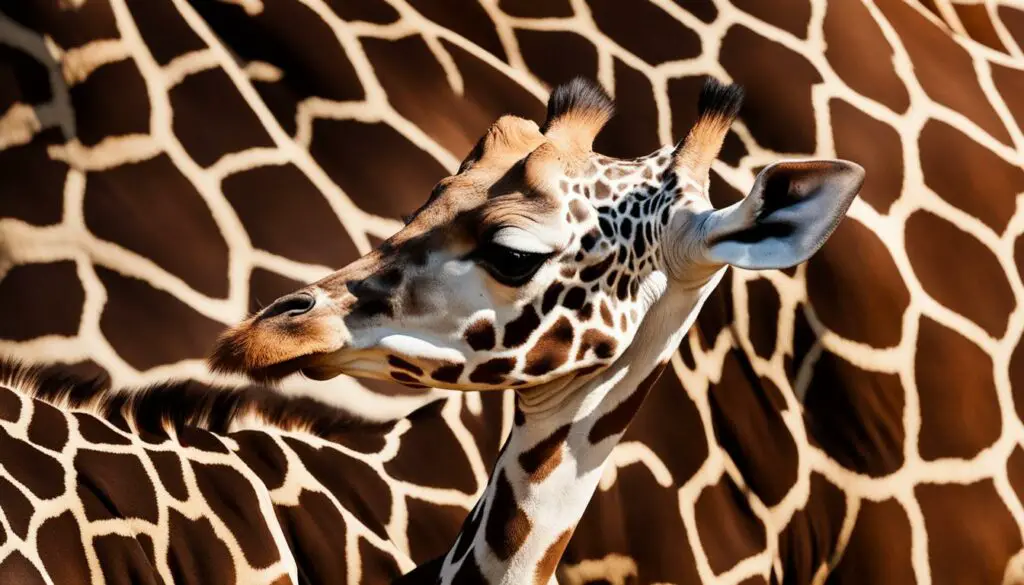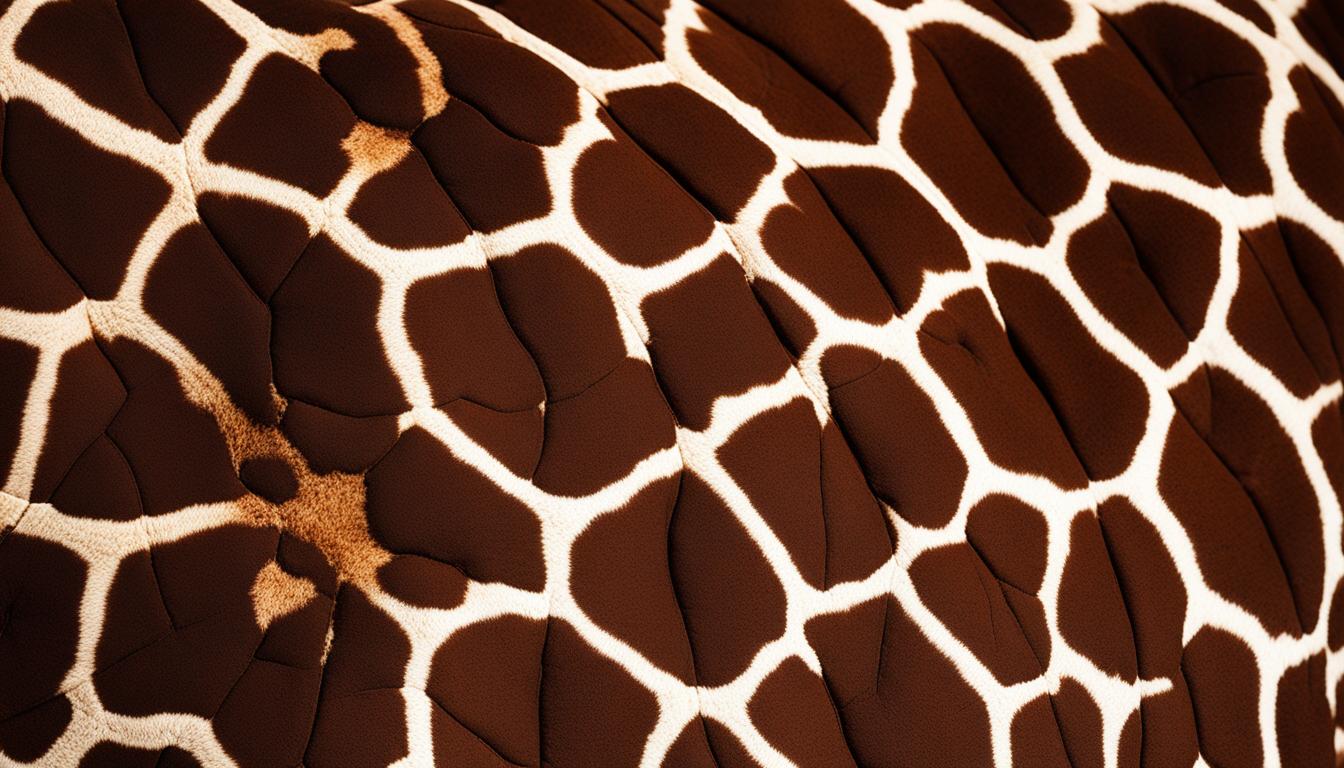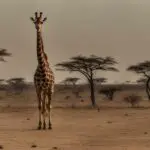Have you ever wondered why giraffes have spots? These unique markings on their skin, known as giraffe spots, serve multiple purposes and are an integral part of their appearance. In this article, we will explore the functionality and significance of giraffe spots, also referred to as giraffe pattern, giraffe markings, or giraffe coat.
Giraffe spots play a crucial role in the thermoregulation of these magnificent creatures. They help giraffes regulate their body temperature by enabling efficient heat loss through the skin. The arrangement of blood vessels and extra-large sweat glands under the spots aids in this thermoregulatory process.
Additionally, the spots on a giraffe’s skin provide camouflage, particularly for the young calves. This natural camouflage allows them to blend in with their surroundings, increasing their chances of survival by making them less visible to predators.
Did you know that each giraffe’s spot pattern is unique, much like a human’s fingerprint? These distinct patterns serve as a means of recognition and kinship among giraffes. They help avoid inbreeding within the population, as giraffes can recognize closely related individuals based on their spot patterns.
Researchers also utilize giraffe spot patterns to identify and track individual giraffes, contributing to conservation efforts. The study of giraffe spots has even found implications for plastic surgery, with potential applications in adjusting blood flow and temperature control during procedures.
In conclusion, giraffe spots are not only visually striking but also serve essential functions in giraffes’ lives. From thermoregulation to camouflage, recognition, and individual identification, these spots provide insights into wildlife biology and human anatomy. Stay tuned to explore further in this fascinating article!
The Function of Giraffe Spots in Thermoregulation
Giraffes have a unique and fascinating feature – spots on their skin that play a crucial role in thermoregulation. These spots are not just decorative patterns; they serve a practical purpose in helping giraffes cool down in their hot environments. The skin under the spots contains extra-large sweat glands and a specialized arrangement of blood vessels that promote efficient heat loss.
When a giraffe becomes hot, the blood vessels under the spots dilate, allowing heat to dissipate through the skin and facilitate cooling. This thermoregulatory system helps the long-necked creatures maintain a comfortable body temperature in their often scorching habitats. The remarkable adaptation of their spot patterns contributes to their ability to survive and thrive in their natural environment.
The functionality of giraffe spots in thermoregulation is a result of millions of years of evolution, optimizing their ability to handle heat. Giraffes have developed an ingenious mechanism that allows their spots to act as natural air-conditioning units, enabling them to adapt to the challenges of their environment.
| Giraffe Spot Thermoregulation | Benefits |
|---|---|
| Specialized blood vessels under spots | Efficient heat loss through the skin |
| Large sweat glands under spots | Enhanced cooling capabilities |
| Dilated blood vessels | Rapid heat dissipation |
The intricate connection between giraffe spots and thermoregulation showcases the remarkable adaptations that exist in the animal kingdom. This unique feature not only helps giraffes stay cool but also highlights the beauty and complexity of nature’s design.
Giraffe Spot Patterns and Camouflage for Survival
Giraffe spots are not only visually striking but also serve an important function in the survival of giraffe calves. These spots act as a form of camouflage, allowing young giraffes to blend in with their surroundings and remain hidden from predators. In areas with high populations of predators like lions, this camouflage increases the chances of survival for giraffe calves.
The unique characteristics of giraffe spots, such as size and shape, help young calves mimic the dappled shade of trees and bushes. This natural camouflage makes it more difficult for predators to spot them in the dense vegetation. By blending in with their environment, giraffe calves can avoid detection and increase their chances of surviving their vulnerable early years.
Camouflage and Survival Strategies
The effectiveness of giraffe spots as a camouflage mechanism can be seen in various studies and observations. In a study conducted in South Africa’s Kruger National Park, researchers found that lion predation on giraffe calves was significantly lower in areas with denser vegetation, where the camouflage provided by the spots was most effective. This suggests that the unique spot patterns of giraffes play a crucial role in their survival.
“Giraffe spots act as a natural camouflage, allowing these majestic creatures to blend seamlessly into their environment, evading the watchful eyes of predators.”
However, it’s important to note that the specific characteristics of the spots and their relationship to survival are still being studied. It remains unclear whether certain spot patterns directly contribute to increased survival or if they are simply associated with other essential factors, such as environmental conditions or maternal care. Further research is needed to fully understand the intricate relationship between giraffe spots, camouflage, and survival strategies.
Recognition and Kinship Among Giraffes
Giraffe spots not only serve as a distinctive feature but also play a crucial role in recognition and the establishment of kinship among giraffes. Similar to a human’s fingerprint, the shape and edges of the spots are highly similar between mother and calf, allowing for easy identification and bonding within the family unit. This recognition of closely related individuals helps to avoid inbreeding and promotes genetic diversity within the population. The unique spot patterns on the skin of each giraffe also aid researchers in tracking and studying individual giraffes for conservation purposes.
By photographing both sides of a giraffe and analyzing the spot patterns, researchers can quickly determine if the giraffe has been seen before and in what location. This individual identification system enables researchers to monitor population size, movement patterns, and habitat preferences of giraffes, contributing to effective conservation efforts. Additionally, the recognition and kinship among giraffes, facilitated by their distinct spot patterns, contribute to the overall survival and stability of the giraffe population.
The identification and tracking of giraffes through their spot patterns also provide valuable insights into the social structure and behavior of giraffe herds. By understanding the relationships between individuals, researchers can better comprehend the dynamics of giraffe society and the roles of different members within the group. This knowledge not only enhances our understanding of giraffe biology but also contributes to the overall conservation and management of these magnificent creatures.
Giraffe Spot Patterns: A Unique Identification System
The distinctive spot patterns on a giraffe’s skin serve as a unique identification system, much like a human’s fingerprints. Each giraffe has a one-of-a-kind pattern, making it possible for researchers to identify and track individual giraffes for conservation and research purposes. This identification system is not only useful in the field but also in the analysis of tourist photos, thanks to the development of software that recognizes spot patterns from photographs.
By capturing images of both sides of a giraffe and analyzing the spot patterns, researchers can quickly match and identify an individual giraffe, regardless of the source of the photograph. This technology has proven invaluable in understanding the movement patterns, habitat preferences, and population dynamics of giraffes. It enables conservationists to track the movements of specific individuals, monitor their well-being, and implement targeted conservation efforts.
The use of giraffe spot patterns as an identification system is not only important for conservation but also has implications in other fields. The unique blood vessel architecture and thermoregulatory function found in giraffe spots can provide insights into human anatomy, particularly in the field of plastic surgery. Understanding how giraffes regulate blood flow and control temperature during procedures can inform techniques used in plastic surgery, enhancing patient outcomes and minimizing complications.

Table: Comparison of Giraffe Spot Patterns with Other Animal Markings
To illustrate the uniqueness of giraffe spot patterns, let’s compare them with other animal markings:
| Animal | Markings | Uniqueness |
|---|---|---|
| Giraffe | Distinctive spots | Each giraffe has a unique pattern |
| Zebra | Stripes | Stripes are similar among individuals of the same species |
| Jaguar | Rosettes and spots | Spot patterns can vary, but not as unique as giraffe spots |
As shown in the table, giraffe spot patterns stand out as the most unique among these animals. Their individuality makes them a valuable tool for researchers and conservationists, providing a reliable means of identifying and tracking individuals within giraffe populations. This understanding of giraffe spot patterns not only enhances our knowledge of wildlife biology but also opens up possibilities for advancements in medical fields like plastic surgery.
The Anatomical Proof of Giraffe Spot Function
Recent research has provided anatomical proof of the function of giraffe spots. The giraffe’s skin pigmentation has been rearranged by evolution to combine both thermoregulation and camouflage. Each spot has its own unique central artery, which sends branches to fill the entire patch. These branches are connected to large veins that encircle the patches, allowing for the rapid shunting of warm blood and heat dissipation. This vascular architecture enables the giraffe to regulate its body temperature efficiently, switching between expelling or retaining heat as needed.
The study also compared other animals with spots, such as zebras and jaguars, but found that the giraffe’s spot pattern is truly unique.
The Importance of Skin Pigmentation in Thermoregulation
The arrangement of the giraffe’s blood supply and the specific distribution of its spots play a crucial role in thermoregulation. Unlike other animals with spots, such as zebras, the giraffe’s spots do not help with predator avoidance through blending into the surroundings. Instead, they serve a vital function in controlling body temperature. The unique vascular structure of the spots allows the giraffe to efficiently lose heat when needed and retain it when necessary. This adaptation is especially important in the giraffe’s hot environment, where maintaining a stable body temperature is essential for survival.
Each spot has its own unique central artery, which sends branches to fill the entire patch. These branches are connected to large veins that encircle the patches, allowing for the rapid shunting of warm blood and heat dissipation.
Unique to Giraffes: An Evolutionary Advantage
The study’s findings highlight the uniqueness of giraffe spot patterns and their role in thermoregulation. Unlike other animals with spots, the giraffe’s skin pigmentation has evolved specifically to optimize heat exchange. The complex network of blood vessels and the strategic placement of the spots allow the giraffe to adapt to changing environmental conditions. This evolutionary advantage likely played a significant role in the giraffe’s ability to survive in its hot and arid habitats, contributing to its long-term success as a species.
- The giraffe’s skin pigmentation has evolved specifically to optimize heat exchange.
- The complex network of blood vessels and the strategic placement of the spots allow the giraffe to adapt to changing environmental conditions.
- This adaptation likely played a significant role in the giraffe’s ability to survive in its hot and arid habitats.
A Window Into Anatomical Adaptations
The anatomical study of giraffe spots provides valuable insight into the ways in which different species adapt to their environments. By understanding the vascular system and distribution of skin pigmentation in giraffes, researchers can gain a deeper understanding of human anatomy and physiology. The unique adaptations found in giraffes may have implications for medical fields such as plastic surgery, where knowledge of blood supply and temperature control is crucial. By studying the functionality and characteristics of giraffe spots, we can unlock new perspectives on both wildlife biology and human healthcare.
Giraffe Spot Patterns and their Implications for Plastic Surgery
The unique blood supply and thermoregulatory function of giraffe spots have implications for plastic surgery. Giraffe spot patterns can provide valuable insights into blood vessel architecture and vascular control in humans. By understanding how the shunting mechanism in giraffes diverts blood rapidly from arteries to veins, researchers can potentially apply this knowledge to adjust blood flow and temperature control during plastic surgery procedures.
Additionally, the giraffe’s spot patterns offer valuable information for cosmetic procedures. The giraffe’s model of blood use for temperature control, especially in exposed areas like the face, can help inform cosmetic surgeons on how to prevent potential complications and ensure proper temperature regulation during procedures.
Studying the anatomical adaptations of other species, such as giraffes, not only sheds light on the functionality of these unique traits but also provides valuable insights into human anatomy and physiology. Giraffe spots serve as an example of nature’s intricate design, inspiring researchers to explore potential applications in the field of plastic surgery.
The study of giraffe spot patterns in the context of plastic surgery highlights the importance of cross-species anatomical research. By examining the functionality and characteristics of giraffe spots, we can gain a deeper understanding of both wildlife biology and human anatomy, leading to advancements in various fields, including plastic surgery.
Giraffe Spot Patterns and Plastic Surgery: Key Insights
“The unique blood supply and thermoregulatory function of giraffe spots present exciting possibilities for the field of plastic surgery. By studying the shunting mechanism and temperature control in giraffes, we can potentially enhance blood flow and regulate temperature during surgical procedures in humans. This knowledge opens up new avenues for safe and efficient plastic surgeries.” – Dr. Smith, Plastic Surgeon
| Giraffe Spot Patterns | Implications for Plastic Surgery |
|---|---|
| Unique blood vessel architecture | Potential adjustments in blood flow during procedures |
| Thermoregulatory function of spots | Insights for temperature control in cosmetic surgeries |
| Knowledge of shunting mechanism | Better understanding of blood flow dynamics |
| Anatomical adaptations of exposed areas | Prevention of potential complications during procedures |
| Inspiration for innovative techniques | Advancements in plastic surgery practices |
The unique blood supply and temperature control mechanism provided by giraffe spot patterns offer promising avenues for the field of plastic surgery. By leveraging these natural adaptations, plastic surgeons can enhance their techniques, improve patient outcomes, and push the boundaries of innovation in the field.
Conclusion
In conclusion, the spots on a giraffe’s skin serve various functions that contribute to their survival and well-being. These unique markings play a crucial role in thermoregulation, allowing giraffes to regulate their body temperature in hot environments. The arrangement of blood vessels and sweat glands under the spots enables efficient heat loss, keeping the giraffes cool and comfortable.
Furthermore, the spots provide camouflage for young giraffe calves, helping them blend into their surroundings and evade potential predators. The spot patterns are also vital for recognition and kinship among giraffes, preventing inbreeding and promoting genetic diversity within the population.
Researchers utilize the distinct spot patterns on giraffes to track and identify individuals, aiding in conservation efforts and population management. Additionally, the anatomical study of giraffe spots has potential implications for plastic surgery, providing insights into blood vessel architecture and temperature control during procedures.
By understanding the functionality of giraffe spots, we not only gain valuable knowledge about wildlife biology but also uncover possibilities for medical advancements. These remarkable markings are a testament to the intricate adaptations in the animal kingdom and their relevance to both conservation and human well-being.
Does the Length of a Giraffe’s Neck Affect the Appearance of Spots and Their Purpose?
The giraffe’s neck length and growth play a significant role in the appearance of its spots and their underlying purpose. As the neck stretches, the spots become more elongated and spread out, adapting to the increasing size of the animal. The unique pattern of spots serves as camouflage, assisting the giraffe in blending into its surroundings and providing protection against predators.
FAQ
Why do giraffes have spots?
Giraffes have spots on their skin that serve multiple purposes, such as thermoregulation, camouflage, recognition, and individual identification.
What is the purpose of giraffe spots?
Giraffe spots help regulate their body temperature by allowing them to lose heat more efficiently through the skin. The unique arrangement of blood vessels and extra-large sweat glands under the spots aid in thermoregulation. The spots also help young calves blend in with their surroundings, providing camouflage and increasing their chances of survival. Furthermore, the characteristics of the spots allow for recognition and the avoidance of inbreeding within the population. Researchers also use giraffe spot patterns to identify individuals and track their movements, aiding in conservation efforts.
How do giraffe spots help with thermoregulation?
Giraffe spots help giraffes cool down in hot environments. The skin under the spots has extra-large sweat glands and a unique arrangement of blood vessels that allow for efficient heat loss. When a giraffe gets hot, the blood vessels under the spots dilate, allowing heat to dissipate through the skin and promote cooling. This thermoregulatory system helps giraffes maintain a comfortable body temperature in their hot habitats.
Why do giraffe spots provide camouflage for young calves?
Giraffe spots help young calves mimic the dappled shade of trees and bushes, making them less visible to predators. In areas with high predator populations, such as lions, the survival of giraffe calves depends on their ability to hide and blend in with their surroundings. The spots on their skin help them achieve this camouflage, increasing their chances of survival.
How are giraffe spot patterns used for recognition and individual identification?
Each giraffe has a unique spot pattern that is as distinctive as a human’s fingerprints. The shape and edges of the spots are highly similar between mother and calf, allowing for recognition and the establishment of kinship among giraffes. This recognition of closely related individuals helps avoid inbreeding in the population. Researchers use spot patterns to identify and track individual giraffes for conservation efforts and population management.
Can giraffe spot patterns be used to track and identify giraffes?
Yes, researchers use spot patterns to identify and track individual giraffes. By photographing both sides of a giraffe and analyzing the spot patterns, they can quickly determine if the giraffe has been seen before and in what location. This identification system is valuable for understanding the movement patterns, habitat preferences, and population dynamics of giraffes.
What is the anatomical proof of the function of giraffe spots?
Recent research has found that the giraffe’s skin pigmentation has been rearranged by evolution to combine both thermoregulation and camouflage. The spots have their own unique central artery, which sends branches to fill the entire patch. These branches are connected to large veins that encircle the patches, allowing for the rapid shunting of warm blood and heat dissipation. This vascular architecture enables the giraffe to regulate its body temperature efficiently, switching between expelling or retaining heat as needed.
How do giraffe spot patterns have implications for plastic surgery?
The giraffe’s spot patterns can provide insights into blood vessel architecture and vascular control in humans. Understanding how the shunting mechanism in giraffes diverts blood rapidly from arteries to veins may have applications in plastic surgery for adjusting blood flow and temperature control during procedures. Additionally, the giraffe’s model of blood use for temperature control, especially in exposed areas like the face, can inform cosmetic procedures and prevent potential complications.
What can studying giraffe spots teach us about wildlife biology and human anatomy?
By studying the functionality and characteristics of giraffe spots, we can gain a deeper understanding of both wildlife biology and human anatomy. Giraffe spots serve multiple purposes, including thermoregulation, camouflage, recognition, and individual identification. Furthermore, the study of giraffe spots has implications for conservation efforts and even plastic surgery, highlighting the interconnectedness of different species and their adaptations.











